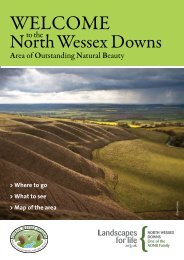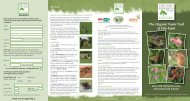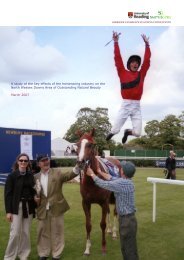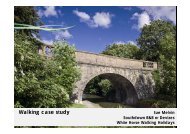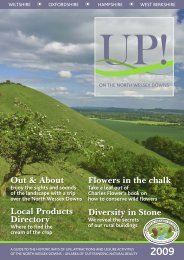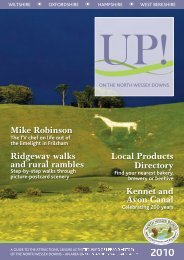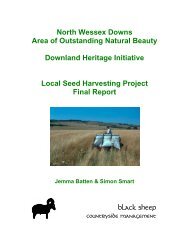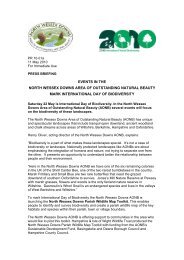UP! - North Wessex Downs Area of Outstanding Natural Beauty
UP! - North Wessex Downs Area of Outstanding Natural Beauty
UP! - North Wessex Downs Area of Outstanding Natural Beauty
Create successful ePaper yourself
Turn your PDF publications into a flip-book with our unique Google optimized e-Paper software.
Yellowhammer<br />
Picture: Tom Marshall<br />
Skylark plot Picture: Diane Nicolle<br />
Farmland<br />
birds at risk …<br />
Lapwing<br />
Grey partridge<br />
Corn bunting<br />
Turtle dove<br />
Yellow wagtail<br />
Tree sparrow<br />
Skylark<br />
Yellowhammer<br />
Linnet<br />
Reed bunting<br />
Hampshire, Berkshire and Oxfordshire,<br />
is based at the AONB’s <strong>of</strong>fice: “I have<br />
been heartened by the positive<br />
response from the local farming<br />
community to the Farmland Bird<br />
Package. Research, combined with<br />
practical experience on farms, has<br />
shown that by providing sufficient<br />
quantities <strong>of</strong> the Big 3 farmers can<br />
boost numbers <strong>of</strong> our declining<br />
farmland birds and therefore also help<br />
the wider populations in the<br />
surrounding countryside.”<br />
Big 3 gains can be achieved in various<br />
ways. Look out for Environmental<br />
Stewardship farming examples if you are<br />
taking a country walk.<br />
Skylark plots (pictured above) can look as<br />
if farmers have missed an area while<br />
seeding. They have – but deliberately.<br />
Winter-sown crops will have grown quite<br />
thick by the time skylarks arrive to breed.<br />
These plots act as landing strips for<br />
skylarks to get into the dense crop, where<br />
they can safely feed and nest.<br />
Overwintered stubble (what’s left after<br />
the crop has been harvested) (main<br />
picture) provides seeds as a winter food<br />
source for farmland birds including grey<br />
partridges and corn buntings.<br />
Uncropped cultivated margins enable<br />
rare wild plants to flower and attract<br />
insects – food in the summer for chicks.<br />
Wild bird seed mixtures. <strong>Area</strong>s <strong>of</strong> arable<br />
land devoted to growing a mixture <strong>of</strong><br />
seed-rich plants provide farmland birds<br />
such as corn buntings, linnets and tree<br />
sparrows with food through the winter.<br />
Wildflower and grass<br />
buffer strips.<br />
Wildflowers are an<br />
important source <strong>of</strong><br />
nectar for insects which<br />
are food for chicks.<br />
Grass margins also<br />
provide insects and are a<br />
nesting habitat for some<br />
farmland birds including<br />
grey partridge.<br />
More details:<br />
diane.nicollerspb.org.uk<br />
01488 680452<br />
sarah.blythrspb.org.uk<br />
07818 807480. ■<br />
Yellow Wagtail Picture: Andy Hay<br />
<strong>UP</strong>! On The <strong>North</strong> <strong>Wessex</strong> <strong>Downs</strong> | 13




